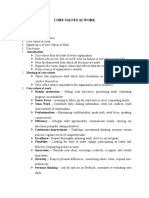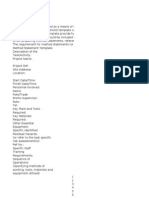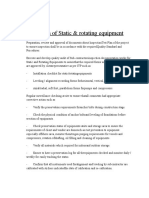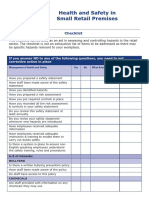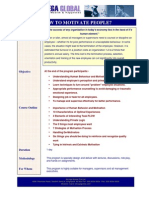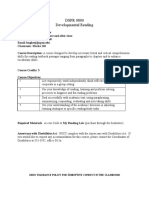A Made To Order Form For Instructional Observation (Peer Version)
A Made To Order Form For Instructional Observation (Peer Version)
Uploaded by
mrajisCopyright:
Available Formats
A Made To Order Form For Instructional Observation (Peer Version)
A Made To Order Form For Instructional Observation (Peer Version)
Uploaded by
mrajisOriginal Description:
Original Title
Copyright
Available Formats
Share this document
Did you find this document useful?
Is this content inappropriate?
Copyright:
Available Formats
A Made To Order Form For Instructional Observation (Peer Version)
A Made To Order Form For Instructional Observation (Peer Version)
Uploaded by
mrajisCopyright:
Available Formats
A Made-to-Order Form for Instructional Observation
(Peer Version)
ORGANIZATION
Begins class on time in an orderly, organized fashion
Previews lecture/discussion content
Clearly states the goal or objective for the period
Reviews prior class material to prepare students for the content to be covered
Provides internal summaries and transitions
Does not digress often from the main topic
Summarizes and distills main points at the end of class
Appears well-prepared for class
PRESENTATION
Incorporates various instructional supports like slides, films, diagrams, etc.
Uses instructional support effectively
Responds to changes n student attentiveness
Uses a variety of spaces in the classroom from which to present material (i.e., does not
hide behind the podium)
Blackboard writing is large and legible
Speech fillers, (for example, OK, ahm) are not distracting
Speaks audibly and clearly
Uses gestures to enhance meaning and not to release nervous tension (repetitive gestures
tend to do the latter)
Communicates a sense of enthusiasm and excitement toward the content
Use of humor is positive and appropriate
Presentation style facilitates note-taking
Speech is neither too formal not too casual
Establishes and maintains eye contact with students
Talks to the students, not the board or windows
Varies the pace to keep students alert
Selects teaching methods appropriate for the content
RAPPORT
Praises students for contributions that deserve commendation
Solicits student feedback
Requires student thought and participation
Responds constructively to student opinions
Knows and uses student names
Does not deprecate student ignorance or misunderstanding
Responds to students as individuals
Treats class members equitably
Listens carefully to student comments and questions
Tailors the course to help many kinds of students
Recognizes when students do not understand
Encourages mutual respect among students
Credibility and control
Responds to distractions effectively yet constructively
Uses authority in classroom to create an environment conducive to learning
Speaks about course content with confidence and authority
Is able to admit error and/or insufficient knowledge
Respects constructive criticism
CONTENT
Includes illustrations
Selects examples relevant to student experiences and course content
Integrates text material into class presentations
Relates current course content to whats gone before and will come after
Relates current course content to students general education
Makes course content relevant with references to real world applications
Presents views other than own when appropriate
Seeks to apply theory to problem-solving
Explicitly states relationships among various topics and facts/theory
Explains difficult terms, concepts, or problems in more than one way
Presents background of ideas and concepts
Presents pertinent facts and concepts from related fields
Presents up-to-date developments in the field
Relates assignments to course content
Clearly organizes assignments
Carefully explains assignments
INTERACTION
Encourages student questions, involvement, and debate
Answers student questions clearly and directly
Uses rhetorical questions to gain student attention
Gives students enough time to respond to questions
Refrains from answering own questions
Responds to wrong answers constructively
Allows ample time for questions
Encourages students to respond to each others questions
Encourages students to answer difficult questions be providing cues and encouragement
Allows relevant student discussion to proceed uninterrupted
Presents challenging questions to stimulate discussion
Respects diverse points of view
ACTIVE LEARNING (LABS, PE ACTIVITIES, ETC.)
Clearly explains directions or procedures
Clearly explains the goal of the activity
Has readily available materials and equipment necessary to complete the activity
Allows opportunity for individual expression
Provides practice time
Gives prompt attention to individual problems
Provides individuals constructive verbal feedback
Careful safety supervision is obvious
Allows sufficient time for completion
Provides enough demonstrations
Demonstrations are clearly visible to all students
If the discovery method is employed, schedules time for discussion of results
Required skills are not beyond reasonable expectations for the course and/or students
Provides opportunities for dialogue about the activity with peers and/or the instructor
Allocates sufficient clean-up time within the class session
You might also like
- Metacognitive Awareness Inventory With Scoring GuideDocument4 pagesMetacognitive Awareness Inventory With Scoring Guidesabrsyed100% (1)
- Philosophy Theory of Truth Methodolog y To Arrive at The Truth Theory of What Is Available/ Good Goal of Teaching and LearningDocument4 pagesPhilosophy Theory of Truth Methodolog y To Arrive at The Truth Theory of What Is Available/ Good Goal of Teaching and LearningIan Dante Arcangeles73% (15)
- Health Safety and Environmental Management Plan - C01Document43 pagesHealth Safety and Environmental Management Plan - C01Mamuka ShaorshadzeNo ratings yet
- KSADocument40 pagesKSAValaki MimiNo ratings yet
- Level 3 Health and Safety in The WorkplaceDocument5 pagesLevel 3 Health and Safety in The WorkplaceKannan JaganNo ratings yet
- 6 On 2 Off Rotating Shift ScheduleDocument11 pages6 On 2 Off Rotating Shift ScheduleAchmad AlbarNo ratings yet
- Project Execution Plan For TankDocument3 pagesProject Execution Plan For TankiwansalmaNo ratings yet
- Daily Lesson Plan: Cognitive: Psychomotor: AffectiveDocument2 pagesDaily Lesson Plan: Cognitive: Psychomotor: Affectivejen mcbrideNo ratings yet
- Module 8 PPSTDocument16 pagesModule 8 PPSTSky jacob PorrasNo ratings yet
- Quality Concept Lesson 1Document37 pagesQuality Concept Lesson 1AbdullahKedahiNo ratings yet
- Conduct of PCN Examinations: NDTS India (P) LimitedDocument11 pagesConduct of PCN Examinations: NDTS India (P) LimitedVasanth Praveen KumarNo ratings yet
- 760C Tapping MachineDocument6 pages760C Tapping MachineTunjung Wicaksana RanukusumaNo ratings yet
- HC Quality ManualDocument45 pagesHC Quality Manualjhen_marcelo@yahoo.com100% (1)
- ABS Rules & Guides PDFDocument6 pagesABS Rules & Guides PDFJorge Adrian Rojo UbedaNo ratings yet
- I-Et-3010.2d-1200-200-P4x-004 - Requeriments For Piping SupportDocument31 pagesI-Et-3010.2d-1200-200-P4x-004 - Requeriments For Piping SupportRodger SenaNo ratings yet
- Maintenance Work Planning & SchedulingDocument4 pagesMaintenance Work Planning & Schedulingcenk saral100% (1)
- Method of Statement-SamsungDocument7 pagesMethod of Statement-Samsunggururaj100% (1)
- Employee TurnoverDocument77 pagesEmployee TurnoverManpreet Kaur VirkNo ratings yet
- Inspection RoleDocument18 pagesInspection Rolesribd9128No ratings yet
- Equipment Lease Agreement 11Document3 pagesEquipment Lease Agreement 11Jun-d SelloteNo ratings yet
- STOD OTP PMT 0808 PM PRO 0003 Project Status Report ProcedureDocument15 pagesSTOD OTP PMT 0808 PM PRO 0003 Project Status Report Procedurejfl2096No ratings yet
- Planning A ProjectDocument33 pagesPlanning A ProjectLjuba SindzirevicNo ratings yet
- Sop Fall ArreasterDocument27 pagesSop Fall ArreasterHse DepartmenNo ratings yet
- Programme of Training Course On EU Funding OpportunitiesDocument4 pagesProgramme of Training Course On EU Funding OpportunitiesNastea IonasNo ratings yet
- Project Status Report SummaryDocument2 pagesProject Status Report Summaryjaning1590No ratings yet
- Failure Mode and Effect Analysis - FMEADocument64 pagesFailure Mode and Effect Analysis - FMEAtanto_deep_15No ratings yet
- EIA Complaints and AppealsDocument19 pagesEIA Complaints and AppealscankawaabNo ratings yet
- UNSW Environment PolicyDocument2 pagesUNSW Environment Policyho100hoNo ratings yet
- Interclene 5012Document4 pagesInterclene 5012Trịnh Minh KhoaNo ratings yet
- Construction, Installation, Hook-Up & Commissioning Impact Assessment, Mitigation and MonitoringDocument40 pagesConstruction, Installation, Hook-Up & Commissioning Impact Assessment, Mitigation and Monitoringsiddiquiee74No ratings yet
- WSH Profile 2014 by MomDocument62 pagesWSH Profile 2014 by MomAaron Bourne LeeNo ratings yet
- International Project Management: Vishal Kumar ROLL NO.-59 T.Y.BBM (IB) Ness Wadia College of CommerceDocument11 pagesInternational Project Management: Vishal Kumar ROLL NO.-59 T.Y.BBM (IB) Ness Wadia College of CommerceVishal MehtaNo ratings yet
- Manpower Planning & Resourcing Mu001 B0816Document11 pagesManpower Planning & Resourcing Mu001 B0816anithanhNo ratings yet
- HRSG Inspection Services - 2 PDFDocument4 pagesHRSG Inspection Services - 2 PDFNuraini LusiNo ratings yet
- Core Values at Work: OutlineDocument2 pagesCore Values at Work: OutlineHarsh Anchalia0% (1)
- 040C04 - Guidelines For Preparation of ITPsDocument9 pages040C04 - Guidelines For Preparation of ITPsHashem GamNo ratings yet
- Seminar Objectives: Offshore Facility Process Safety OverviewDocument11 pagesSeminar Objectives: Offshore Facility Process Safety OverviewCarlos Domingo Roland CheekNo ratings yet
- Template Removable Media ProcedureDocument2 pagesTemplate Removable Media ProcedureYogesh JoshiNo ratings yet
- Method StatementDocument20 pagesMethod StatementClinton LindemannNo ratings yet
- 18 PartsDocument2 pages18 PartsHarraKiriNo ratings yet
- IGN 2021 01 Guidance On Safe Use of Grass Cutting MachineDocument16 pagesIGN 2021 01 Guidance On Safe Use of Grass Cutting MachineRinto SilalahiNo ratings yet
- Epci Websites (Autorecovered)Document48 pagesEpci Websites (Autorecovered)Shittu Ahmed OlanrewajuNo ratings yet
- MCOT 013 Pig Receiving From 4B 18in Crude LineDocument18 pagesMCOT 013 Pig Receiving From 4B 18in Crude LineLembang ApangNo ratings yet
- Line Breaking, Blinding & De-Blinding ProcedureDocument39 pagesLine Breaking, Blinding & De-Blinding Procedureaimanshirin5No ratings yet
- Inspection DocumentDocument3 pagesInspection DocumentNaiyer Karimi100% (1)
- Matterhorn Steel Catenary Risers Critical Issues and Lessons Learned For Reel-Layed SCRs To A TLPDocument16 pagesMatterhorn Steel Catenary Risers Critical Issues and Lessons Learned For Reel-Layed SCRs To A TLPTee Shi FengNo ratings yet
- Health and Safety ChecklistDocument5 pagesHealth and Safety ChecklistNaMeiNaNo ratings yet
- ProjectClosureReport-v1 0Document83 pagesProjectClosureReport-v1 0WellfroNo ratings yet
- Diesel Engine Exhaust Spark Arrestors: Key Features and BenefitsDocument8 pagesDiesel Engine Exhaust Spark Arrestors: Key Features and BenefitsSandiSandiiNo ratings yet
- "Implementing Lean Construction in Ashghal ": Ciht 19 February 2019Document54 pages"Implementing Lean Construction in Ashghal ": Ciht 19 February 2019Mohammed MuzakkirNo ratings yet
- S1-Gas Production SystemDocument25 pagesS1-Gas Production SystemMd Abid AfridiNo ratings yet
- Ball Valve FCTDocument16 pagesBall Valve FCTAnggi SujiwoNo ratings yet
- Consultancy - Good Practice GuideDocument20 pagesConsultancy - Good Practice Guidejvigforu100% (1)
- 12 Life Saving RulesDocument1 page12 Life Saving RulesHerawan MulyantoNo ratings yet
- List of Documents ISO 9001 Documentation Toolkit en PDFDocument2 pagesList of Documents ISO 9001 Documentation Toolkit en PDFyounNo ratings yet
- JSA For LiftingDocument2 pagesJSA For LiftingXUE JIANNo ratings yet
- Middle East CaravanDocument20 pagesMiddle East CaravanB2B AFRICANo ratings yet
- Notes To File Guidance 04-20-12Document3 pagesNotes To File Guidance 04-20-12Sashwat TanayNo ratings yet
- HSE Training PlantDocument16 pagesHSE Training PlantdikdikNo ratings yet
- Annual Report: Royal Dutch Shell PLC Annual Report and Form 20-F For The Year Ended December 31, 2009Document192 pagesAnnual Report: Royal Dutch Shell PLC Annual Report and Form 20-F For The Year Ended December 31, 2009Khageshwar RongkaliNo ratings yet
- Ramel Ornales Construction SuperintendentDocument6 pagesRamel Ornales Construction SuperintendentIndustrial WeldersNo ratings yet
- Roles and Responsibilities of Safety ProfessionalDocument1 pageRoles and Responsibilities of Safety Professionalrnp2007123No ratings yet
- CHIRANJEEVIDocument38 pagesCHIRANJEEVIshanmukhpavantejNo ratings yet
- PPG 215 Meeting Student NeedsDocument24 pagesPPG 215 Meeting Student NeedsmrajisNo ratings yet
- TBE Part ADocument99 pagesTBE Part AmrajisNo ratings yet
- Presentation 1Document1 pagePresentation 1mrajisNo ratings yet
- PPG 215 TesolDocument23 pagesPPG 215 TesolmrajisNo ratings yet
- Peer Observation BDocument8 pagesPeer Observation BmrajisNo ratings yet
- Towards A Reflective Classroom Peer Observation: Badre Abdeslam TESOL Conference 2008 Morocco 1Document19 pagesTowards A Reflective Classroom Peer Observation: Badre Abdeslam TESOL Conference 2008 Morocco 1mrajisNo ratings yet
- English Language Teaching Methods: PPG215 Semester 1, 2014/2015Document41 pagesEnglish Language Teaching Methods: PPG215 Semester 1, 2014/2015mrajisNo ratings yet
- Lesson Planning: PPG215 Semester 1, 2014/2015Document28 pagesLesson Planning: PPG215 Semester 1, 2014/2015mrajisNo ratings yet
- Classroom Observation Form CDocument5 pagesClassroom Observation Form CmrajisNo ratings yet
- Classroom Observation WorksheetDocument5 pagesClassroom Observation WorksheetmrajisNo ratings yet
- Classroom Observation WorksheetDocument5 pagesClassroom Observation WorksheetmrajisNo ratings yet
- Motivate PeopleDocument1 pageMotivate PeoplemrajisNo ratings yet
- 3d Kuala Lumpur Highlight TourDocument1 page3d Kuala Lumpur Highlight TourmrajisNo ratings yet
- Bps - Amega Nao OrientationDocument3 pagesBps - Amega Nao OrientationmrajisNo ratings yet
- Amega BookDocument8 pagesAmega BookmrajisNo ratings yet
- Gwenhyvar Lewin - Scoring RubricDocument1 pageGwenhyvar Lewin - Scoring Rubricapi-547539690No ratings yet
- Instructional Modifications For ElsDocument2 pagesInstructional Modifications For Elsapi-729485085No ratings yet
- Guang-Guang, Dahican, City of Mati, Davao Oriental, 8200Document1 pageGuang-Guang, Dahican, City of Mati, Davao Oriental, 8200JaysonNo ratings yet
- Lesson Plan in English 7Document4 pagesLesson Plan in English 7Ronalee AgustinNo ratings yet
- Training Program PlanDocument12 pagesTraining Program Planapi-281596713No ratings yet
- Project Approach Final PaperDocument6 pagesProject Approach Final Paperapi-270064896No ratings yet
- Caregiving 3Document14 pagesCaregiving 3Bianca SandovalNo ratings yet
- Disclosure Document Ap Us History 2Document3 pagesDisclosure Document Ap Us History 2api-234159772No ratings yet
- Reflection Curriculum Development ModelsDocument1 pageReflection Curriculum Development Modelsjonalyn felipe100% (1)
- Models of Teaching - Assignment OumDocument37 pagesModels of Teaching - Assignment OumLeela Subramaniam Leela100% (1)
- RR843: An Investigation of Personalised Learning: Approaches Used by SchoolsDocument80 pagesRR843: An Investigation of Personalised Learning: Approaches Used by SchoolsttrbNo ratings yet
- Sse 201 Lesson 3bDocument12 pagesSse 201 Lesson 3bRex VelascoNo ratings yet
- DSPR 0800 SyllabusDocument6 pagesDSPR 0800 Syllabusj_hughes_16No ratings yet
- Shared Reading - The Wonky DonkeyDocument3 pagesShared Reading - The Wonky DonkeyEL Khadra TvNo ratings yet
- CertificatesDocument9 pagesCertificatesSam MeringueNo ratings yet
- Managing Tle Time During Practical ActivitiesDocument19 pagesManaging Tle Time During Practical ActivitiesLyn GangcuangcoNo ratings yet
- Resume-Kristen BarnettDocument1 pageResume-Kristen Barnettapi-214196279No ratings yet
- DO5s2024 Orientation Material 2Document106 pagesDO5s2024 Orientation Material 2michaelvincent.monteroNo ratings yet
- Address: Brgy. Bayorbor, Mataasnakahoy, Batangas (043) 741-8878Document2 pagesAddress: Brgy. Bayorbor, Mataasnakahoy, Batangas (043) 741-8878Zia MolaNo ratings yet
- Cityscape Drawing LessonDocument5 pagesCityscape Drawing Lessonapi-252035920No ratings yet
- Think-Pair-Share Word Wall: Curriculum Focus AreaDocument5 pagesThink-Pair-Share Word Wall: Curriculum Focus AreaGMToivonenNo ratings yet
- GED 109 - Inquiry-Based ProjectDocument2 pagesGED 109 - Inquiry-Based ProjectMaila PaguyanNo ratings yet
- Mooc4 Ce171389Document4 pagesMooc4 Ce171389Tran Phuong AnhNo ratings yet
- The Causes of Passiveness in Learning of Vietnamese StudentsDocument13 pagesThe Causes of Passiveness in Learning of Vietnamese StudentsNguyen Quang MinhNo ratings yet
- Cot Lesson Plan SampleDocument4 pagesCot Lesson Plan Samplemaffy fernandezNo ratings yet
- Science and TechnologyDocument4 pagesScience and TechnologysakinahNo ratings yet


































